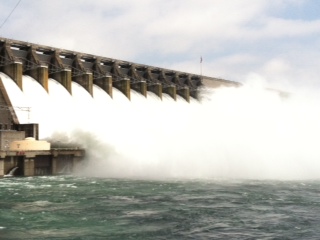Corps Bracing for Weather Extremes This Fall and Winter
 We could see extremely low water levels on Hartwell Lake come this fall because of a lack of rainfall this summer, but the U.S. Army Corps of Engineers is also preparinga for record flood stage levels come winter.
We could see extremely low water levels on Hartwell Lake come this fall because of a lack of rainfall this summer, but the U.S. Army Corps of Engineers is also preparinga for record flood stage levels come winter.
It’s a strange case of two extremes coming one after the other. First, unusually low rainfall amounts over the spring and summer have Northeast Georgia inching near drought status.
Using the current conditions in the Savannah River Basin as indicators, the Corps is expecting to reach drought trigger level 2 by October, according to Corps spokesman Russell Wicke.
“In the winter, full pool is 656ft msl and drought trigger level 1 occurs at 654 ft msl and drought trigger 2 is two feet below that,” Wicke said. “I would say that’s a reasonable expectation, that we would be right around 652ft msl which is below the winter draw down.”
As of Friday, Hartwell Lake’s level stood at 656 ft above mean sea level, about four feet below full summer pool, but normal for the fall and winter months. As a result of the rainfall deficit this summer, portions of the Savannah River Basin are abnormally dry, and a few places are in moderate drought.
Right now, Hartwell inflows are 22 percent of normal, and at Thurmond they are 19 percent of normal. Wicke said even assuming inflows improve to 75 percent of normal in the coming weeks, the Corps’ 10-week projection has us brushing up against Drought Level 2 by October.
However, Wicke said the Corps is also monitoring an El Nino effect currently moving through the South Pacific across India, Asia, and Australia that he said is expected to hit North America this winter.
“There are El Nino conditions right now in the Pacific and they’re projected to be very strong conditions by the time winter rolls around,” he explained. “In fact, it’s unusual how strong the conditions are right now for El Nino. The last time it was this strong was the 1997-1998 winter. And if you go back and look at those years and what kind of water conditions we were dealing with at that time, we were getting more water than we could deal with.”

In the spring of 2013, heavy rainfall caused Hartwell Lake to rise five feet above full pool, prompting the Corps to open the Dam’s floodgates.
And Wicke said, if this El Nino effect is as strong as predicted, we could see higher flood stage levels this winter at Hartwell Dam than we had in the spring of 2013 when record rainfall pushed lake levels five feet above flood stage.
Still, Wicke said while the Corps doesn’t manage basin levels based on weather predictions, he said they are expecting to see record high water levels this winter beginning in December
“That’s one of the main reasons why we do winter draw dows; it’s to make room for that winter rainfall,” Wicke said. “You get more run-off per inch of rain in the winter than the summer. Winter run-off is a lot higher than summer run-off. That’s one of the main reasons we do a winter draw down – to make room for that anticipated, greater inflow of water.”
Wicke said the Corps will continue to monitor the current El Nino effect and make adjustments to their predictions as needed.
